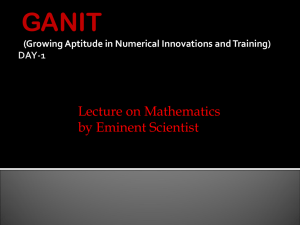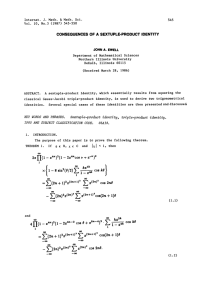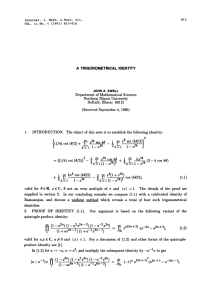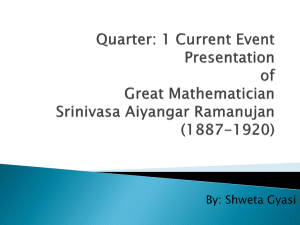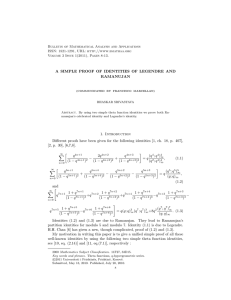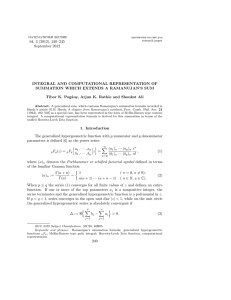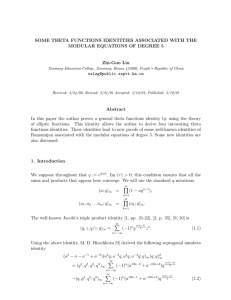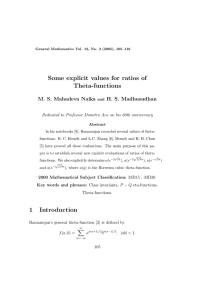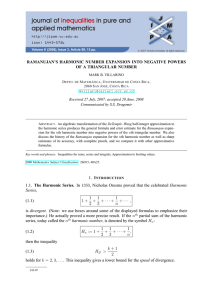Document 10485539
advertisement
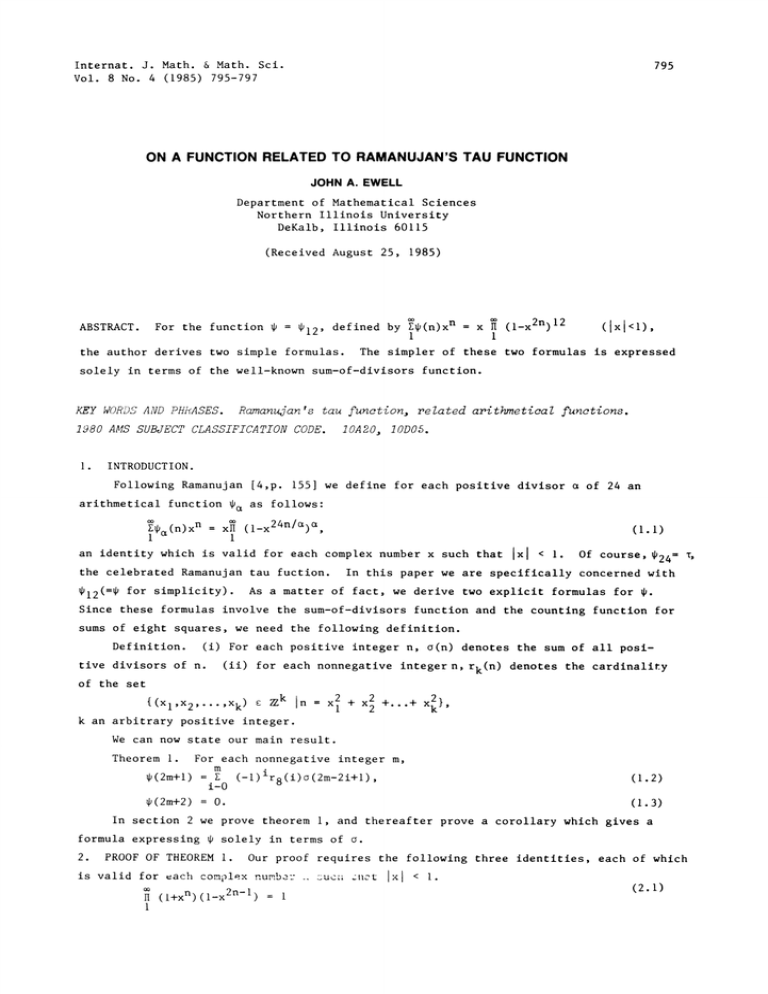
Internat. J. Math. & Math. Sci.
Vol. 8 No. 4 (1985) 795-797
795
ON A FUNCTION RELATED TO RAMANUJAN’S TAU FUNCTION
JOHN A. EWELL
Department of Mathematical Sciences
Northern Illinois University
DeKalb, Illinois 60115
(Received August 25, 1985)
For the function
ABSTRACT.
12’
defined by
(n)xn
x
The simpler of these two formulas is expressed
the author derives two simple formulas.
solely in terms of the well-known sum-of-divisors function.
KEY WORDS AND PHRASES. Ramanujan’s tau function, related arithmetical
1980 AMS SUBJECT CLASSIFICATION CODE. 10A20, 10D05.
i.
functions.
INTRODUCTION.
Following Ramanujan [4,p. 155] we define for each positive divisor
(n)x
,
as follows:
arithmetical function
x
n
(l-x24n/)
(I.I)
an identity which is valid for each complex number x such that
the celebrated Ramanujan tau fuction.
12(=
of 24 an
for simplicity).
Ixl
<
I.
Of course,
24
.
In this paper we are specifically concerned with
As a matter of fact, we derive two explicit formulas for
Since these formulas involve the sum-of-divisors function and the counting function for
sums of eight squares, we need the following definition.
(i) For each positive integer n, o(n) denotes the sum of all posi-
Definition.
(ii) for each nonnegative integer n,
tive divisors of n.
of the set
k In
{(Xl,X 2
Xk
k an arbitrary positive integer.
x x
+
+...+
rk(n
denotes the cardinality
x},
We can now state our main result.
Theorem i.
For each nonnegative integer m,
m
(2m+I)
i-0
(-i) i rs(i)o(2m-2i+l),
(1.2)
(2m+2)
0.
(1.3)
In section 2 we prove theorem i, and thereafter prove a corollary which gives a
formula expressing
2.
solely in terms of
PROOF OF THEOREM i.
Our proof requires the following three identities, each of which
is valid for ach complex number
H
.
(i+xn)(1-x 2n-I)
uc et
Ixl
<
I.
(2 I)
J.A. EWELL
796
(l-xn)(l
x
(-x) n2
2n-l)
(2.2)
x n(n+1)/2
(l-x2n)(l+x n)
(2.3)
0
Identity (2.1) is due to Euler, while (2.2) and (2.3) are due to Gauss.
[3, pp. 277-284].
locate in the literature.
LEMMA.
Proof:
This we here record in the following lemma.
For each complex number
0
For proofs see
We also need a fourth identity which the author has not been able to
Ixl
such that
x
<
I,
xm(m+l)/2}4 (2m+1)xm
0
(2.4)
Here we need the following two identities, stated and proved in [I, p. 313].
(1-x2n)2(l+x2n-l { x2m2} 2
(l-x2n)2(l-x2n-l)4
+
x{ x2m(m+1)} 2
x2m2} 2
{
x{ x2m(m+l)} 2
We square these identities, add the resulting identities, and utilize the fact that the
fourth power of the right side of (2.2) generates
to write:
(-l)nr4(n),
20 r4(2n)x2n
0
r4(n)x n +
2
0
0
(-l)nr4(n)xn
r4(n)x2n + 2x2{
x2m(m+l)} 4,
whence
x2{ x2m(m+l)} 4
)]x 2n
[r4(2n)-r4(n
0
[
(4m)-r4 (2m) ]x4m
0 r4
+
r4(2m+l)]x4m+2
Z[r4(4m+2)
0
[24o(2m+i)
8o(2m+l)]x 4m+2
0
24
E o(2m+l)x 4m+2
0
Here, we’ve made use of Jacobi’s formula for
ly letting x
x I/4
r4(n).
Now, cancelling
24x 2
and subsequent-
we obtain (2 4)
Continuing with the proof of theorem I, we use (2.1) to rewrite (2.3) as
(l-xn)(l-x2n-l) -2
xn(n+l)/2
0
We then raise the identity to the fourth power, and multiply the resulting identity by
the eighth power of identity (2.2) to get
H(l_x n) 12
{Z
i=O
(-x) n2 }8
(_l)ir 8(i) xi
xn
n=O
{ xn(n+l)/2}4
i=O
I
o(2j+l) xj
j=O
(-l)ir 8 (i)o (2n-2i+I).
FUNCTION RELATED TO RAMANUJAN’S TAU FUNCTION
In the foregoing we then let x
(n)x n
x.
2,
and multiply the resulting identity by x to get
(l-x 2n) 12
x 2m+I
0
0
Comparing coefficients of
x
797
xn
(-l)ir8(i)o(2m-2i+l)
we thus prove our theorem.
By appeal to the well-known formula for r 8, viz.,
16(-l)ndn (-l)dd3’
r8(n)
+
n
(e.g., see [3, p. 314]), we eliminate r 8 from (1.2) as follows:
(2m+i)
o(2m+i) + 16
m
o(2m-2i+i) Z
(-l)dd 3
i=l
In order to extend the inner sum over all
divides i, to be 0, otherwise.
d
to be i, if
in the range
d
(2m+I)
m i
l
i=l d=l
m
o(2m+I) + 16 Y.
o(2m+I) + 16 E
i we define (i,d)
Hence,
(-1)do(2m-2i+l)e(i,d)d 3
m
(-I) d d 3 Y.
g(i,d)o(2m-2i+l)
i=d
d=1
m
1,2
(_l)dd
3 l o(2m-2kd+1)
d=l
k=l
The upper limit of summation of the sum indexed by k is naturally [m/d], the integral
o(2m+l) + 16 I
part of m/d.
Thus, we have proved the following
COROLLARY.
For each nonnegative integer m,
m
(2m+1)
o(2m+l) + 16 I
(-1) dd 3
d=l
CONCLUDING REMARKS.
m/d
l o(2m-2kd+l).
k=l
According to Hardy, Ramanujan conjectured that each of the
dividing 24) is multiplicative" e.g., see [2, p. 184].
(for
were later confirmed by L. J. Mordell.
Jacobi,
i
and
4’ 6
and
8"
3
are trivially defined.
These conjectures
Owing to classical identities of Euler and
Ramanujan himself deduced formulas for
2’
REFERENCES
I.
EWELL, J.A.
Completion of a
Gaussian derivation, Proc.
Amer. Math. Soc.
8__4 (1982),
311-314.
HARDY, G.H.
3.
Ramanujan, Chelsea, New York, 1959.
HARDY, G.H. and WRIGHT, E.M. An introduction to the theory of numbers, 4th ed.,
Clarendon Press, Oxford, 1960.
4.
RAMANUJAN, S.
2.
Collected papers, Chelsea, New York 1962.
